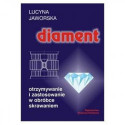Oj nie wkleiło mi się poprzednio:
Mixed Decay Operation
The automatic mixed decay feature of the A3977 optimizes the current-chopping mode for the best sinusoidal current waveform for microstepping.
Slow decay (Fig. 7) has the advantage of minimum current ripple. However, when microstepping at higher step rates, slow decay chopping may fail to properly regulate current on the backside of the sine wave when current drops — a result of motor BEMF overriding the voltage applied to the motor, forcing the current to increase during the decay. Fig. 8 is a scope plot of A3977 motor current that illustrates the limitations of slow decay chopping. This distortion in the current causes increased audible noise in the motor.
Fast decay (Fig. 7) solves the current regulation problem of slow decay. With approximately the full (-) supply across the motor winding, it can quickly get the current out of the winding. The disadvantage of fast decay is the increased current ripple, which in turn causes increased motor heating.
Mixed decay (Fig. 7, on page 52) splits the fixed off time of the PWM cycle into fast and then slow decay. When the current reaches Itrip, the device goes into fast decay mode until the voltage on the RC pin decays to the voltage on the PFD pin (VPFD). The approximate time the device operates in fast decay (tFD) is tFD=R×C×ln(VDD×0.6/VPFD) (6)
Where:
VDD=Applied voltage
After this tFD portion, the device switches to slow decay mode for the remainder of the fixed off time period. The result is low current ripple, but with increased bandwidth to track the ideal sine wave for microstepping.
Although mixed decay improves microstepping performance, it still has higher current ripple than slow decay. The best solution is to use a slow decay on the front side of the sine wave and mixed decay on the backside of the sine wave output. When a step command signal occurs on the Step input the translator sequences the DACs to the next level. If the new DAC output level is lower than the previous level then decay mode for that H-bridge will be set by the voltage level on the PFD input (fast, slow, or mixed decay). If the new DAC level is higher or equal to the previous level, then the decay mode for that H-bridge will be slow decay. Fig. 9, on page 54, is a scope plot of the A3977 with slow decay on the front side and mixed decay on the backside. For comparison, see the motor current scope plot of the A3977, set to 100% fast decay on the backside of the sine wave and slow decay on the front side in Fig.10, on page 54.











